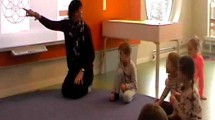Abstract
The purposes of this study are to examine young children’s explanations of floating and sinking and to investigate how scaffolding strategies provided by a tutor could promote their scientific understandings. Fifteen 4-year-olds and fifteen 5-year-olds from a public kindergarten in northern Taiwan participated in this study. The children were interviewed before and after an instructional intervention to examine their understandings about how the weight, volume, and material of an object are related to sinking and floating. During the intervention, children manipulated objects made of different materials and were assigned to one of the three groups: scaffolding-material (provided with teaching scaffolding and allowed to see the materials of the objects), scaffolding (teaching scaffolding only), and material groups (seeing the materials only). In the first two groups, 16 teaching strategies based on six scaffolding principles were employed. Analyses of interviews showed that before the intervention, the 4-year-olds seemed to have a variety of explanations for sinking and floating and a majority of the 5-year-olds used weight as an explanation for floatation. After the intervention, both 4- and 5-year-olds in the scaffolding-material and scaffolding groups improved their understandings of floating and sinking. Particularly, three out of five 5-years-olds in the scaffolding-material group related the material of an object to its buoyancy and generalized their explanations to the objects made of the same material. The findings suggest that manipulative experiences alone might not be enough for children to further their understandings about floatation and that combining teaching scaffolding with children’s perceiving of the materials of objects is more effective. This study provides insight into how to support young children to learn science through effective teaching strategies.
Similar content being viewed by others
References
Bredekamp S, Copple C (eds) (1997) Developmentally appropriate practice in early childhood programs. National Association of the Education of Young Children, Washington, DC
Butts DP, Hofman H, Anderson M (1993) Is hands-on experience enough? A study of young children’s view of sinking and floating objects. J Element Sci Educ 5(1):50–64
Creswell JW (2007) Qualitative inquiry and research design: choosing among five approaches, 2nd edn. Sage, Thousand Oaks, CA
Fretz EB, Wu H-K, Zhang B, Krajcik JS, Davis EA, Soloway E (2002) An investigation of software scaffolds supporting modeling practices. Res Sci Educ 32(4):567–589
Hadzigeorgiou Y (2002) A study of the development of the concept of mechanical stability in preschool children. Res Sci Educ 32:373–391
Heath PA, Heath P (1982) The effect of teacher intervention on object manipulation in young children. J Res Sci Teach 19(7):577–585
Huberman AM, Miles MB (1994) Data management and analysis methods. In: Denzin NK, Lincoln YS (eds) Handbook of qualitative research. Sage, Thousand Oaks, CA, pp 428–444
Kohn AS (1993) Preschooler’s reasoning about density: will it float? Child Dev 64:1637–1650
Metz KE (1995) Reassessment of developmental constrains on children’s science instruction. Rev Educ Res 65(2):93–127
Metz KE (1997) On the complex relation between cognitive developmental research and children’s science curricula. Rev Educ Res 67(1):151–163
Palincsar AM, Brown AL (1984) Reciprocal teaching of comprehension-fostering and comprehension-monitoring activities. Cogn Instr 1(2):117–175
Pea RD (2004) The social and technological dimensions of scaffolding and related theoretical concepts for learning, education, and human activity. J Learn Sci 13(3):423–451
Piaget J (2001) The children’s conception of physical causality. Transaction, London
Quintana C, Reiser BJ, Davis EA, Krajcik J, Fretz E, Duncan RG et al (2004) A scaffolding design framework for software to support science inquiry. J Learn Sci 13(3):337–386
Reiser BJ (2004) Scaffolding complex learning: the mechanisms of structuring and problematizing student work. J Learn Sci 13(3):273–304
Smith C, Carey S, Wiser M (1985) On differentiation: a case study of the concept of size, weight and density. Cognition 21:177–237
Stone CA (1998) The metaphor of scaffolding: Its utility for the field of learning disabilities. J Learn Disabil 31(4):344–364
Tenenbaum HR, Rappolt-Schlichtmann G, Zanger VV (2004) Children’s learning about water in a museum and in the classroom. Early Child Res Quart 19:40–58
Vygotsky LS (1978) Mind in society: the development of higher psychological processes. Harvard University Press, Cambridge, MA
Wood D, Bruner JS, Ross G (1976) The role of tutoring in problem solving. J Child Psychol Psychiatry 17:89–100
Acknowledgments
This study was supported in part by the National Science Council of Taiwan under NSC 93-2511-S-003-028 and NSC 97-2511-S-003-024-MY3. The authors wish to thank the kindergarten teachers and the children for their support and participation.
Author information
Authors and Affiliations
Corresponding author
Rights and permissions
About this article
Cite this article
Hsin, CT., Wu, HK. Using Scaffolding Strategies to Promote Young Children’s Scientific Understandings of Floating and Sinking. J Sci Educ Technol 20, 656–666 (2011). https://doi.org/10.1007/s10956-011-9310-7
Published:
Issue Date:
DOI: https://doi.org/10.1007/s10956-011-9310-7




